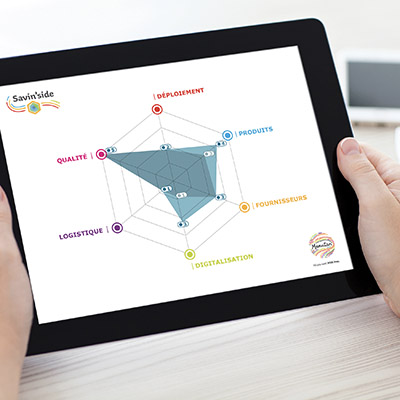In an ever-evolving and highly competitive business landscape, finding a trustworthy supplier is a strategic decision. Understanding how to choose suppliers suited to your organisation has a decisive impact on the competitiveness and overall performance of any company, regardless of their field of activity. To find the ideal supplier, two main steps prevail: Defining selection criteria and establishing a supplier evaluation method.
What selection criteria should you use to find a supplier?
Any sourcing process starts with qualifying your needs and conducting initial research in the supplier market. This involves exploring marketplaces, contacting several potential suppliers, and obtaining basic information. After this, procurement departments must focus on defining selection criteria.
How to define selection criteria
Finding the right suppliers involves the simultaneous consideration of multiple criteria. The nature of the criteria and their degree of importance vary depending on the types of purchases and the strategy implemented by each company. In parallel, market size and the number of suppliers can also influence these elements.
The idea is to identify the criteria on which these potential suppliers will be evaluated, with one objective: To measure their performance. Some criteria are essential, such as price and quality, while others are less obvious but no less important, depending on initial needs.
Price
Unsurprisingly, the net price of products is among the main selection criteria for suppliers. It’s an essential criterion, as it will have a direct impact on the company’s margin and profitability.
Quality
The quality of the products and, more broadly, the quality of service are also two indispensable notions. To ensure that these elements meet the expected quality standards, companies can rely on labels, certifications, or customer reviews received by suppliers.
Current situation
It’s also crucial to ensure the financial health and market reputation of suppliers. This includes their solvency, the absence of ongoing legal cases, and (again) customer opinions and feedback.
Associated services
Some types of purchases require particular support. This can take several forms:
- Customer service;
- Technical assistance;
- Product repair service;
- Collection and reuse solutions for used products…
Some services are included in the initial price, while others incur additional costs that must be considered.
Innovation
Innovation can also be a factor in supplier selection. Gary Gustafson, president of G-Force Consulting, is convinced of the importance of such a criterion: "If a buyer partners with a supplier who is established but who doesn’t master new technologies, they may receive a lesser service because this supplier won’t be able to bring new design ideas."
CSR
To prioritise the selection of committed suppliers, it’s appropriate to integrate corporate social responsibility (CSR) criteria. This can cover environmental management of activities, ethical practices, the place of diversity and inclusion in human resource management, or policy certification (EcoVadis, ISO 20400…).
Additional criteria for finding a supplier
Beyond these key examples, there is, of course, a multitude of additional criteria:
- Reliability and delivery times;
- Production capacity;
- Geographical location;
- Technical capability;
- Past performance;
- Warranty policy;
- Inventory management;
- Payment terms and conditions…
These criteria provide key information on the services that suppliers are likely to produce, as well as on the choice of products that the company can buy. By carefully identifying these indicators, it ensures finding suppliers with the stature, skills, and knowledge necessary to meet its current and future challenges.
What evaluation method(s) should you use to find suppliers?
After choosing supplier selection criteria, it’s appropriate to adopt an evaluation method. There are different models for identifying the best suppliers capable of meeting the company’s needs.
Criteria weighting
This involves assigning a weight to each criterion, subjectively. Then, multiply the performance score assigned to a supplier with the weighting of each criterion. By adding up the sum of these scores, the company obtains an overall evaluation of this supplier. This process, widely used in procurement departments, largely relies on the experience and judgement of buyers.
Categorisation method
The idea is to categorise suppliers according to their strategic positioning and the criticality of their products to better manage the supplier network. We find, for example, partner suppliers, strategic, preferred, niche, local, general… Selection criteria then depend on the category to which the suppliers belong. This allows for a clear and systematic structuring of the supplier evaluation process.
Total cost-based method
This approach consists of identifying and calculating the costs generated by all activities involved in the procurement operation. This includes:
- Transport and receipt of goods;
- Order placement;
- Product quality control;
- Etc.
This usually opens discussions and negotiations on cost values with suppliers. Two key methods stand out in this area: Total Cost of Ownership (TCO) and Life Cycle Cost (LCC).
Categorical method
This method relies mainly on the experience and expertise of the company’s employees. It involves asking different departments’ members (procurement, quality, production, sales…) to give their opinion on a list of suppliers and their performance, based on criteria they deem important. During evaluation meetings, each shares their opinion, and the buyer determines an overall score based on their feedback. This relatively simple approach to implement thus relies on both objective and subjective criteria.
Again, this is just a non-exhaustive overview. There are many other methods that rely just as much on quantitative and qualitative parameters to find the right suppliers. Because each has its own advantages and disadvantages, the important thing is to adapt it to your resources and procurement strategy.
Finding quality suppliers suited to your company is essential to ensure long-term success. Determining relevant selection criteria and adopting the right evaluation method are two key steps to ensure effective supplier selection, but also to lay the foundations for a good supplier relationship. This allows procurement departments to make informed decisions to reduce costs and maximise the total value of products, while reducing risks. It’s therefore the starting point for creating and maintaining a reliable and efficient supply chain in the long term.









